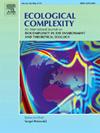The Rosenzweig-MacArthur predator-prey model is the building block in modeling food chain, food webs and ecosystems. There are a number of hidden assumptions involved in the derivation. For instance the prey population growth is logistic without predation but also with predation. In order to reveal these we will start with modelling a resource-predator-prey system in a closed spatially homogeneous environment. This allows us to keep track of the nutrient flow. With an instantaneous remineralisation of the products excreted in the environment by the populations and dead body mass there is conservation of mass. This allows for a model dimension reduction and yields the mass balance predator-prey model. When furthermore the searching and handling processes are much faster that the population changing rates, the trophic interaction is described by a Holling type II functional response, also assumed in the Rosenzweig-MacArthur model. The derivation uses an extended deterministic model with number of searching and handling predators as model variables where the ratio of the predator/prey body masses is used as a mechanistic time-scale parameter. This extended model is also used as a starting point for the derivation of a stochastic model. We will investigate the stochastic effects of random switching between searching and handling of the predators and predator dying. Prey growth by consumption of ambient resources is still deterministic and therefore the stochastic model is hybrid. The transient dynamics is studied by numerical Monte Carlo simulations and also the quasi-equilibrium distribution for the population quantities is calculated. The body mass of the prey individual is the scaling parameter in the stochastic model formulation. This allows for a quantification of the mean-field approximation criterion for the justification of replacement of the stochastic by a deterministic model.


